Denver Itinerary 4 Days: How to Spend a Perfect Weekend in the Mile High City
Denver, the capital of Colorado, is a vibrant and diverse city that offers a wide range of attractions and activities for visitors of all ages and interests. Whether you are looking for outdoor adventures, cultural experiences, or urban delights, Denver has something for everyone. In this article, we will show you how to spend a perfect weekend in Denver Itinerary 4 Days which covers the best things to do, see, and eat in the city and its surroundings.
Before You Go!
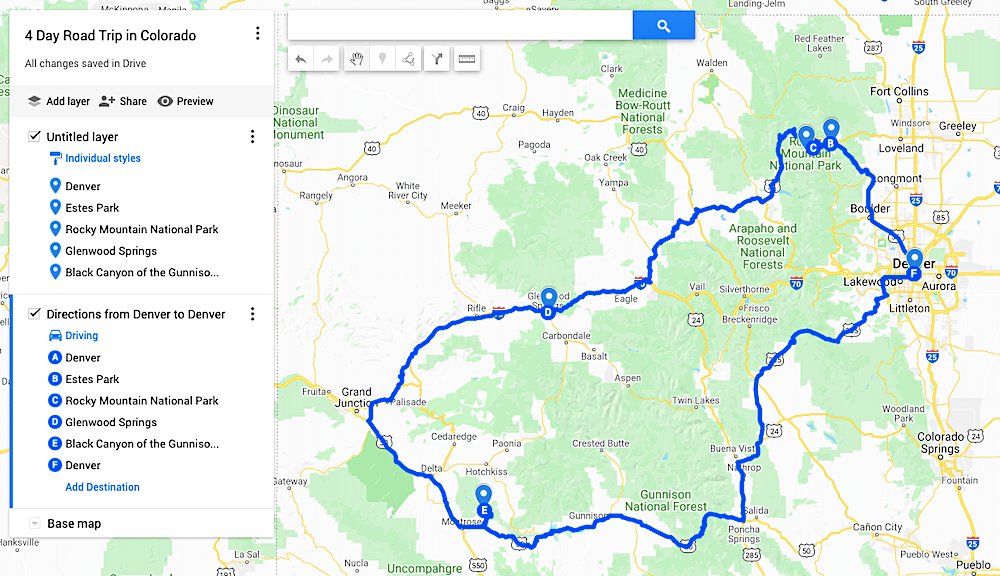
- Denver is a great destination for a weekend getaway, as it has a lot of attractions and activities to suit different tastes and preferences.
- You can explore the city’s history, culture, and art by visiting its museums, galleries, and landmarks, such as the Denver Art Museum, the Denver Botanic Gardens, and the Colorado State Capitol.
- You can enjoy the city’s nightlife, dining, and entertainment options by checking out its neighborhoods, such as LoDo, RiNo, and Cherry Creek.
- You can experience the beauty and adventure of the Rocky Mountains by taking day trips to nearby destinations, such as Rocky Mountain National Park, Winter Park, and Estes Park.
- You can save money and time by purchasing a CityPASS Denver, which gives you access to some of the most popular attractions in the city for one low price.
Estimated Costs
The cost of your trip to Denver will depend on various factors, such as your travel style, preferences, and season. However, to give you a general idea, here are some estimated costs of transportation, accommodation, food, and activities for a 4-day trip to Denver.
| Item | Cost |
| Transportation | $200 |
| Accommodation | $400 |
| Food | $200 |
| Activities | $100 |
| Total | $900 |
Transportation
The transportation cost includes the round-trip flight from New York to Denver, which is around $150 per person, and the public transportation or rideshare costs within the city, which is around $50 per person. You can also rent a car if you plan to visit places outside the city, which will cost around $40 per day.
Accommodation
The accommodation cost is based on the average price of a 3-star hotel in Denver, which is around $100 per night. You can find cheaper or more expensive options depending on your budget and preferences. You can also consider staying in an Airbnb, a hostel, or a campground to save money or have a different experience.
Food
The food cost is based on the average price of a meal in Denver, which is around $15 per person. You can find cheaper or more expensive options depending on your appetite and preferences. You can also save money by cooking your own food if you have access to a kitchen or by buying groceries and snacks from supermarkets or convenience stores.
Activities
The activity cost is based on the price of a CityPASS Denver, which is $64 per person. This pass gives you access to 3 or 4 attractions of your choice, such as the Denver Art Museum, the Denver Zoo, the Denver Museum of Nature & Science, and the Downtown Aquarium. You can also find free or low-cost activities in the city, such as visiting parks, gardens, and public art installations.
Day 1: Explore the City of Denver Itinerary 4 Days
On your first day in Denver, you will explore the city’s history, culture, and art by visiting some of its museums, galleries, and landmarks. You will also get a taste of the city’s nightlife, dining, and entertainment options by checking out some of its neighborhoods.
Morning: Denver Art Museum and Colorado State Capitol
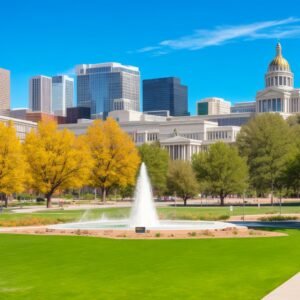
Start your day by visiting the Denver Art Museum, one of the largest and most renowned art museums in the country. The museum features a permanent collection of more than 70,000 works of art from around the world, as well as temporary exhibitions and special events.
You can admire the museum’s stunning architecture, which consists of two buildings: the North Building, designed by Italian architect Gio Ponti, and the Hamilton Building, designed by American architect Daniel Libeskind.
You can also explore the museum’s various galleries, which showcase art from different regions, periods, and genres, such as American Indian, Asian, European, African, modern, and contemporary art. The museum also has interactive and educational programs for children and families, such as the Just for Fun Family Center, the Kids Corner, and the Create-n-Takes. The museum is open from 10 a.m. to 5 p.m. daily, except on Mondays, when it is closed.
The admission fee is $13 for adults, $10 for seniors and students, $8 for youth (6-18), and free for children (5 and under). You can also visit the museum for free on the first Saturday of every month. The museum is included in the CityPASS Denver, which gives you access to 3 or 4 attractions of your choice for one low price.
After visiting the museum, walk for about 15 minutes to the Colorado State Capitol, the seat of the Colorado General Assembly and the office of the governor and lieutenant governor. The capitol is a beautiful and historic building that was completed in 1894 and modeled after the United States Capitol.
The capitol is famous for its distinctive gold dome, which was added in 1908 and covered with real gold leaf to commemorate the Colorado Gold Rush. The capitol is also known for its Mile High Marker, which is a brass plaque on the 13th step of the west entrance that marks the elevation of 5,280 feet above sea level. You can take a free guided tour of the capitol, which lasts about an hour and covers the history, architecture, and artwork of the building. You can also climb to the top of the dome, which offers panoramic views of the city and the mountains. The tours are offered from 10 a.m. to 3 p.m. Monday through Friday, except on holidays.
You need to make a reservation online or by phone in advance. You can also visit the capitol on your own, but you will not be able to access the dome or some of the rooms.
Afternoon: Denver Botanic Gardens and Cherry Creek
After visiting the capitol, take a bus or a rideshare to the Denver Botanic Gardens, one of the most popular and beautiful attractions in the city. The gardens span more than 40 acres and feature more than 15,000 species of plants from around the world. You can stroll through the gardens, which are divided into different zones, such as the Tropical Conservatory, the Japanese Garden, the Water Garden, the Rock Alpine Garden, and the Mordecai Children’s Garden. You can also enjoy the stunning views from the observation decks, the sculptures and artworks throughout the gardens, and the seasonal events and exhibits, such as the Blossoms of Light, the Orchid Showcase, and the Summer Concert Series. The gardens are open from 9 a.m. to 5 p.m. daily, except on Thanksgiving, Christmas, and New Year’s Day. The admission fee is $15 for adults, $12 for seniors and students, $9 for youth (3-15), and free for children (2 and under). The gardens are included in the CityPASS Denver, which gives you access to 3 or 4 attractions of your choice for one low price.
After visiting the gardens, take a bus or a rideshare to Cherry Creek, one of the most upscale and trendy neighborhoods in Denver. Cherry Creek is known for its shopping, dining, and entertainment options, as well as its art and culture scene. You can browse the shops and boutiques at the Cherry Creek Shopping Center, which is the largest and most luxurious mall in the city, or at the Cherry Creek North, which is a 16-block district of independent and local businesses.
You can also find a variety of restaurants and cafes, ranging from casual to fine dining, serving different cuisines, such as American, Italian, Mexican, Asian, and more. You can also enjoy the nightlife and entertainment options, such as bars, clubs, theaters, and galleries. You can also visit the Cherry Creek Arts Festival, which is an annual event that showcases the works of more than 250 artists, as well as live music, food, and activities. The festival is held every July and attracts more than 350,000 visitors.
Evening: LoDo and Larimer Square

End your day by exploring LoDo and Larimer Square, two of the most historic and lively neighborhoods in Denver. LoDo, which stands for Lower Downtown, is the oldest and original settlement of Denver, dating back to the 1850s. LoDo is now a vibrant and revitalized area that boasts a mix of old and new buildings, as well as a variety of attractions and activities.
You can visit the Union Station, which is a historic train station that has been transformed into a modern hub of transportation, dining, shopping, and entertainment. You can also visit the Coors Field, which is the home of the Colorado Rockies baseball team, and catch a game or take a tour of the stadium.
You can also visit the Tattered Cover Book Store, which is one of the largest and most beloved independent bookstores in the country, and browse the shelves of books, magazines, and gifts. You can also find a lot of bars, pubs, breweries, and restaurants in LoDo, where you can enjoy the local craft beer, wine, and food, as well as the live music and entertainment.
Larimer Square, which is located within LoDo, is the oldest and most historic block in Denver, dating back to the 1860s. Larimer Square is now a charming and elegant area that features restored Victorian buildings, as well as a variety of shops, restaurants, cafes, and bars. You can also enjoy the nightlife and entertainment options, such as comedy clubs, theaters, and live music venues.
You can also admire the lights and decorations that adorn the square, especially during the holidays and special events, such as the Denver Chalk Art Festival, the Oktoberfest, and the Parade of Lights.
Day 2: Rocky Mountain National Park
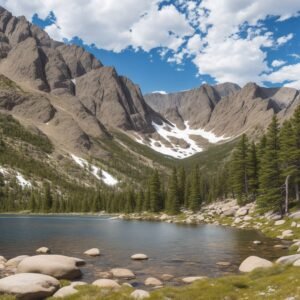
On your second day in Denver, you will experience the beauty and adventure of the Rocky Mountains by taking a day trip to Rocky Mountain National Park, one of the most popular and spectacular national parks in the country.
Rocky Mountain National Park covers more than 400 square miles and features stunning scenery, diverse wildlife, and numerous trails and activities for all levels of visitors.
Morning: Bear Lake and Trail Ridge Road
Start your day by driving to Rocky Mountain National Park, which is about an hour and a half away from Denver. You will need to pay an entrance fee of $25 per vehicle, which is valid for seven days. You can also purchase an annual pass for $80, which gives you access to all national parks and federal recreational lands for a year.
You can also use the free shuttle buses that operate within the park, which will save you time and hassle of finding parking and driving on the narrow and winding roads.
Once you arrive at the park, head to the Bear Lake Trailhead, which is one of the most popular and scenic areas in the park. Bear Lake is a beautiful alpine lake that is surrounded by snow-capped mountains and pine forests. You can take a short and easy hike around the lake, which is about 0.8 miles long and offers stunning views of the lake and the peaks. You can also take longer and more challenging hikes from the trailhead, such as the Emerald Lake Trail, which is about 3.6 miles round trip and leads to three other lakes, or the Flattop Mountain Trail, which is about 8.8 miles round trip and climbs to the summit of Flattop Mountain, which is over 12,000 feet high.
After hiking around Bear Lake, drive to the Trail Ridge Road, which is the highest continuous paved road in the country and one of the most scenic drives in the world. The road stretches for 48 miles and crosses the Continental Divide, reaching an elevation of 12,183 feet. The road offers breathtaking views of the mountains, valleys, meadows, and tundra, as well as the chance to see wildlife, such as elk, bighorn sheep, marmots, and pikas. You can stop at various overlooks and points of interest along the way, such as the Alpine Visitor Center, the Rainbow Curve, the Forest Canyon, and the Lava Cliffs. The road is open from late May to mid-October, depending on the weather and snow conditions.
Afternoon: Grand Lake and Estes Park
After driving along the Trail Ridge Road, you will reach the western side of the park, where you can visit Grand Lake, the largest and deepest natural lake in Colorado. Grand Lake is a charming and quaint town that offers a variety of activities and attractions, such as boating, fishing, swimming, kayaking, and paddle boarding on the lake, hiking, biking, and horseback riding on the trails, and shopping, dining, and relaxing on the main street. You can also visit the Grand Lake Marina, which rents boats and equipment, or the Grand Lake Yacht Club, which hosts sailing races and events. You can also visit the Kauffman House Museum, which is a historic log cabin that was built in 1892 and now serves as a museum that showcases the history and culture of Grand Lake.
After visiting Grand Lake, drive back to the eastern side of the park, where you can visit Estes Park, the gateway to Rocky Mountain National Park and a popular tourist destination. Estes Park is a lively and fun town that offers a lot of attractions and activities, such as shopping, dining, and entertainment on the main street, which is lined with souvenir shops, art galleries, restaurants, cafes, and bars. You can also visit the Estes Park Aerial Tramway, which takes you to the top of Prospect Mountain, where you can enjoy panoramic views of the town and the park. You can also visit the Stanley Hotel, which is a historic and elegant hotel that was built in 1909 and inspired the novel and movie The Shining by Stephen King. You can take a tour of the hotel, which is said to be haunted by ghosts, or stay overnight if you dare.
Evening: Return to Denver Itinerary 4 Days
End your day by driving back to Denver, which will take you about an hour and a half. You can relax and unwind after a long and adventurous day in the mountains, or enjoy the nightlife and entertainment options in the city. You can also plan your next day’s activities, which will include more day trips to nearby destinations, such as Winter Park and Boulder.
Day 3: Winter Park
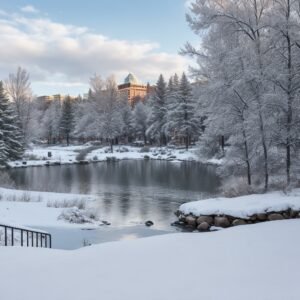
On your third day in Denver, you will enjoy some winter fun by taking a day trip to Winter Park, one of the best ski resorts in Colorado. Winter Park offers a variety of slopes and trails for all levels of skiers and snowboarders, as well as other activities and attractions for non-skiers.
Morning: Skiing and Snowboarding
Start your day by driving to Winter Park, which is about an hour and a half away from Denver. You will need to rent or bring your own ski or snowboard equipment, or you can take a lesson if you are a beginner. You can also purchase a lift ticket or a season pass, which will give you access to the resort’s 3,000 acres of terrain, 166 trails, and 23 lifts. You can choose from different areas of the resort, such as the Winter Park Territory, which has groomed runs, terrain parks, and glades, the Mary Jane Territory, which has moguls, trees, and steeps, the Vasquez Ridge Territory, which has intermediate and advanced runs, the Parsenn Bowl Territory, which has high alpine bowls and glades, and the Eagle Wind Territory, which has backcountry-style terrain. You can also check the resort’s website1 for the latest snow conditions, trail maps, and events.
Afternoon: Tubing and Snowshoeing
After skiing or snowboarding, you can try some other winter activities, such as tubing and snowshoeing. Tubing is a fun and easy way to slide down the snow on a large inflatable tube. You can go to the Coca-Cola Tube Park, which is located at the base of the resort and has four lanes of varying difficulty and a conveyor lift. You can purchase a one-hour or two-hour session, which includes the tube rental and the lift access. You can also go to the Fraser Tubing Hill, which is located about 10 minutes away from the resort and has six lanes and a tow rope. You can purchase a one-hour or two-hour session, which includes the tube rental and the tow access.
Snowshoeing is a great way to explore the natural beauty and wildlife of the area on foot. You can rent snowshoes from the resort or from local shops, or you can join a guided tour. You can choose from different trails, such as the Jim Creek Trail, which is a 3.2-mile round trip and leads to a waterfall, the Broome Hut Trail, which is a 2.4-mile round trip and leads to a backcountry hut, or the Discovery Trail, which is a 1.5-mile loop and leads to a scenic overlook. You can also check the resort’s website1 for more information on snowshoeing.
Evening: Dining and Shopping
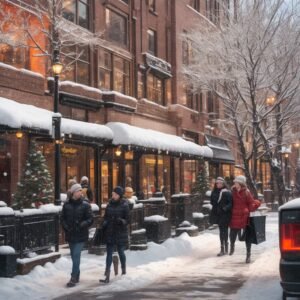
End your day by enjoying some dining and shopping options in Winter Park. You can find a variety of restaurants and cafes, ranging from casual to fine dining, serving different cuisines, such as American, Mexican, Italian, Asian, and more.
You can also find some bars and pubs, where you can enjoy the local craft beer, wine, and cocktails, as well as the live music and entertainment. You can also browse the shops and boutiques, where you can buy souvenirs, gifts, clothing, accessories, and more.
You can also visit the Winter Park Village, which is a pedestrian-friendly area that has a skating rink, a movie theater, a bowling alley, and a spa. You can also check the resort’s website1 for more information on dining and shopping.
Day 4: Boulder
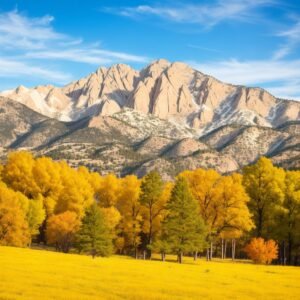
On your fourth and final day in Denver, you will visit Boulder, a charming and progressive city that is home to the University of Colorado and a vibrant cultural and outdoor scene. Boulder offers a lot of attractions and activities for visitors of all ages and interests, such as museums, galleries, parks, trails, and festivals.
Morning: Pearl Street Mall and Boulder Museum of Contemporary Art
Start your day by driving to Boulder, which is about 40 minutes away from Denver. You can park your car at one of the public garages or lots, or you can take a bus or a rideshare. Once you arrive, head to the Pearl Street Mall, which is a four-block pedestrian mall that is the heart of downtown Boulder. You can stroll along the mall, which is lined with historic buildings, colorful murals, and public art installations. You can also browse the shops and boutiques, where you can find everything from books, music, and art to clothing, jewelry, and antiques. You can also find a variety of restaurants and cafes, where you can enjoy a breakfast or a coffee. You can also watch the street performers, who entertain the crowds with music, magic, comedy, and more.
After exploring the mall, walk for about 10 minutes to the Boulder Museum of Contemporary Art, which is a small but impressive museum that showcases the works of local, national, and international artists. The museum features rotating exhibitions and programs that reflect the current trends and issues in contemporary art and culture. You can also visit the museum’s shop, which sells art books, prints, and gifts. The museum is open from 11 a.m. to 5 p.m. Tuesday through Sunday, and from 11 a.m. to 8 p.m. on Wednesday. The admission fee is $2 for adults, $1 for seniors and students, and free for children (12 and under) and members. You can also visit the museum for free on the first Thursday of every month. You can also check the museum’s website2 for more information on the exhibitions and events.
Afternoon: Chautauqua Park and University of Colorado
After visiting the museum, take a bus or a rideshare to Chautauqua Park, which is one of the most popular and scenic parks in Boulder. Chautauqua Park is a historic and cultural landmark that dates back to the late 19th century, when it was part of a nationwide movement to provide education and entertainment to the masses. The park features a large green space, a playground, a picnic area, and a historic auditorium, where you can watch concerts, lectures, and films. The park also offers access to the Flatirons, which are the iconic rock formations that overlook the city. You can hike on the trails that lead to the Flatirons, which offer stunning views of the city and the mountains. You can also climb on the Flatirons, which have routes for all levels of climbers. You can also check the park’s website3 for more information on the park and the auditorium.
After enjoying the park, take a bus or a rideshare to the University of Colorado, which is the flagship campus of the state’s public university system and one of the top research universities in the country. The university has a beautiful and historic campus, which spans more than 600 acres and features Gothic-style buildings, lush gardens, and panoramic views. You can take a self-guided or guided tour of the campus, which will show you the highlights and landmarks, such as the Old Main, the Norlin Library, the Folsom Field, and the Fiske Planetarium. You can also visit the university’s museums, which include the CU Art Museum, the CU Museum of Natural History, and the CU Heritage Center. You can also check the university’s website4 for more information on the campus and the museums.
- The best time to visit Denver depends on your preferences and activities, but generally speaking, spring and fall are ideal for mild weather and fewer crowds. Summer is the peak season for outdoor activities and festivals, but it can also be hot and dry. Winter is great for skiing and snow sports, but it can also be cold and snowy. You can find more information about the best time to visit Denver and the weather by season here1.
- There are many ways to get around in Denver, depending on your budget and convenience. You can use public transportation, such as buses, light rail, and airport rail, operated by the Regional Transportation District (RTD). You can also use taxis, rideshares, or rental cars for more flexibility. If you want to explore the city on foot or by bike, you can take advantage of Denver’s many bike paths, bike rentals, and the free MallRide on the 16th Street Mall. You can find more information about Denver’s transportation options here2.
- There are many other destinations near Denver that you can visit for a day trip or a weekend getaway. Some of the most popular ones are:
- Rocky Mountain National Park, where you can enjoy stunning scenery, wildlife, hiking, and driving on the Trail Ridge Road3.
- Colorado Springs, where you can visit the Garden of the Gods, Pikes Peak, the Air Force Academy, and the Olympic Training Center4.
- Boulder, where you can explore the Pearl Street Mall, the Flatirons, the University of Colorado, and the Boulder Creek Path5.
- Estes Park, where you can experience the charm of a mountain town, shop, dine, and stay at the historic Stanley Hotel6.
- Breckenridge, where you can ski, snowboard, hike, bike, and enjoy the arts and culture of a former mining town7.
- You can book tours and activities in Denver through various online platforms, such as Airbnb Experiences8, GetYourGuide9, and TourRadar10. These platforms offer a wide range of options for different interests, budgets, and durations. You can also find information and reviews from other travelers who have booked the same tours and activities. Some examples of tours and activities in Denver are:
- There are not many beaches in Denver, as it is a landlocked city, but there are some places where you can enjoy the water and the sand. Some of the best beaches in and around Denver are:
- Cherry Creek Park, where you can swim, sunbathe, picnic, and rent boats, jet skis, and paddle boards16
- Confluence Park, where you can swim, watch kayakers, and walk along the Cherry Creek Path17
- Aurora Reservoir, where you can swim, fish, sail, and scuba dive18
- Boulder Reservoir, where you can swim, boat, windsurf, and picnic19
- Chatfield State Park, where you can swim, kayak, canoe, and camp20
- There are many good tour operators for Denver that can help you plan your trip and provide you with quality service and guidance. Some of the best tour companies in Colorado are:
- Aspire Tours, which offers small group tours of Denver, Rocky Mountain National Park, Pikes Peak, and more21
- Colorado Sightseer, which offers customized private tours of Denver, Boulder, Red Rocks, and more22
- Denver Adventures, which offers outdoor activities such as hiking, biking, ziplining, and snowshoeing23
- Denver Microbrew Tour, which offers walking tours of Denver’s craft beer scene and history24
- Mile High Gliding, which offers scenic flights over the Flatirons and Boulder in a sailplane25
I hope this helps you prepare for your trip to Denver Itinerary 4 Days. Here is a table with some FAQs and a pre-trip checklist for your convenience:
| FAQ | Answer |
| What is the best time to visit Denver? | Spring and fall for mild weather and fewer crowds, summer for outdoor activities and festivals, winter for skiing and snow sports. |
| How do I get around in Denver? | Public transportation, taxis, rideshares, rental cars, bikes, or walking. |
| What are some other destinations near Denver? | Rocky Mountain National Park, Colorado Springs, Boulder, Estes Park, Breckenridge, and more. |
| How do I book tours and activities in Denver? | Online platforms such as Airbnb Experiences, GetYourGuide, and TourRadar. |
| What are some popular beaches in Denver? | Cherry Creek Park, Confluence Park, Aurora Reservoir, Boulder Reservoir, Chatfield State Park. |
| What are some good tour operators for Denver? | Aspire Tours, Colorado Sightseer, Denver Adventures, Denver Microbrew Tour, Mile High Gliding. |
| Pre-Trip Checklist | Packing List |
| Check passport validity and visa requirements | Clothing (All Seasons): T-shirts, jeans, shorts, dresses, skirts, underwear, socks, pajamas, swimwear, sunglasses, hat, rain jacket, umbrella |
| Make travel insurance and vaccinations | Additional Items: Toiletries, medications, first aid kit, sunscreen, insect repellent, travel adapter, power bank, phone charger, earphones, camera, memory card, books, magazines, games, snacks, water bottle |
| Photocopy or scan important documents | Hiking Items: Hiking boots, hiking socks, hiking pants, hiking shirt, hiking jacket, backpack, trekking poles, water bladder, trail map, compass, GPS, whistle, flashlight, knife, fire starter, emergency blanket |
| Notify bank and credit card company | Gear: Tent, sleeping bag, sleeping pad, pillow, stove, fuel, cookware, utensils, dishes, cups, food, water, cooler, ice, matches, lantern, chairs, table, hammock, tarp, rope, duct tape |
| Book accommodation and transportation | |
| Download offline maps and apps |
Conclusion:
Denver is a great destination for travelers who want to enjoy the city and the nature. There are many things to do and see in Denver, from museums and art galleries to parks and gardens. There are also many festivals and events that celebrate the culture and diversity of Denver. You can also explore the nearby attractions, such as the Rocky Mountains, the Garden of the Gods, and the Red Rocks Amphitheatre. You can book tours and activities online or through local tour operators. You can also find beaches and swimming areas in and around Denver, where you can relax and have fun. To prepare for your trip, you should check the weather, pack accordingly, and follow the pre-trip checklist. Have a wonderful time in Denver!

